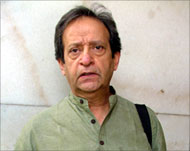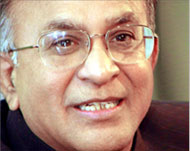Indian Left bloc holds power balance
In just one year, the political left in India has seen its influence grow to the point where it is now the power- broker in the United Progressive Alliance (UPA) coalition government of Prime MInister Manmohan Singh.

The four-party Left bloc, comprising the Communist Party of India-Marxist (CPM), the Communist Party of India (CPI), Forward Bloc (FB) and Republican Socialist Party (RSP), rules only three Indian states and is less than one-ninth of the 545-member people’s house of parliament, the Lok Sabha.
Last year’s parliamentary elections did not yield a clear winner, forcing the Indian National Congress (INC) at 145 seats, to ally with 14 regional parties and form the UPA.
But it still fell short of a simple majority in the Lok Sabha, paving the way for the Left bloc to hold the wild card.
With its record 62 MPs, the left is considered the crutch on which the government stands, even though it has not been included in the UPA government.
D Raja, CPI National Secretary, said: “It is the first time that the left has emerged as an influential partner in governance. Today, its ideological and political influence is quite vast, way beyond its electoral strength.”
Leftist powerhouse
In June, the UPA cabinet cleared a proposal for the partial privatisation of a profit-making giant, Bharat Heavy Electricals Limited, one of the 13 such multi-million dollar units controlled by the government, only to shelve it later under the left’s pressure.
The left has forced a freeze on privatising such public sector units even marginally.
 |
|
Professor Aijaz Ahmed says the |
July saw the Left block flexing its muscle over a sensitive political issue. But for the pressure of the Left parties, the INC would not have removed powerful party members, Jagdish Tytler and Sajjan Kumar, from the government after an official commission of enquiry hinted at their involvement in the 1984 genocide of Sikhs.
Nearly 5000 Sikhs, India’s second largest religious minority after Muslims, were massacred all over India, allegedly, with the overt and covert support of INC leaders, in the aftermath of Prime Minister Indira Gandhi’s assassination by two of her security guards – both Sikhs.
The left block clashed with the government for the second time in July over a deal Singh signed during his US trip – for the import of civilian nuclear technology.
The left is opposed to any strategic tie-up with America.
The following month, because of the left’s vociferous protests in and outside parliament, multinational Honda Motors had to reinstate 57 workers it had earlier sacked.
In September, the left forced the government to amend labour laws after it organised nationwide strikes of government employees protesting at job cuts and loss of pension benefits.
In October, the Left mobilised the country’s top scientists, retired diplomats and intellectuals to unanimously oppose the government’s vote against Iran on the nuclear issue at the International Atomic Energy Agency’s September meeting.
This was followed by fire-and-brimstone public rallies on this issue for three long weeks in November, and the government had to finally commit itself against participating in any IAEA exercise that refers Iran to the UN Security Council.
India, which had earlier voted for the European Union-sponsored resolution condemning Iran for non-compliance with the Nuclear Non-proliferation Treaty, lobbied for Iran at the IAEA’s last meeting, mainly because of the Left’s pressure.
Opposing US policies
Simultaneously, the Left bloc opposed India’s joint air exercises with the US Air Force at the Kalaikund air base in West Bengal in November. Although the 12-day operation did not face any physical disruption, scores of thousands of workers of the Left participated in the anti-America protests outside the airbase.
 |
|
Relatives of killed Sikhs protest |
In their latest row with the government, the Left parties have objected to the appointment of a pro-US security analyst K Subramanayam as chairman of a government task force on global developments.
They claim the task force is the government’s “underhand way of providing sustenance and rationale for the India-US strategic tie up”.
In the ongoing session of parliament, the left is pressing for a formal debate on foreign policy and hopes to get a categorical commitment from the government on an independent foreign policy that keeps India firmly away from the US camp.
Power base
The left’s political base is largely confined to the states of West Bengal (where it has been in government for a record 28 years), Tripura in the east and Kerala in the south.
However, its opposition to the INC-led coalition government, especially in the past six months, has given the Left high visibility in the rest of the country.
 |
|
Jaipal Reddy, a minister from the |
Aijaz Ahmed, visiting professor at Delhi’s prestigious Jawaharlal Nehru University, the cradle of many left leaders in India, said: “Thanks to their vocal opposition to the INC government, news and views about the economy and India’s foreign and defence policy – rather than contentious, communal issues – have moved to the front page today.”
If the INC is uncomfortable about the Left’s surging role in national politics, its leaders are careful not to show it.
Jaipal Reddy, senior INC minister in the UPA cabinet, said: “The Left parties took a very lofty position by extending support to a coalition led by the INC which is its main rival in all its three stronghold states, and they did it to protect and nurse the secular Indian polity.
“Our differences with the Left parties are not those of perspective but of detail,” he said and described the INC-Left alliance as “solid and fairly stable”.
Janaradhana Dwivedi, INC general secretary, agreed: “Our relationship with the Left parties is not as unhappy as it looks.”
Tabs on government
The relationship between the INC and the Left has moulded the latter into the modicum of a government watchdog.
Providing checks and balances while also supporting the government, according to Ahmed, is “an onerous task”.
 |
|
Prakash Karat: Support for |
“At best, the Left parties are like a court of higher appeal to which [faulty] government decisions can be referred.”
The Left may have also sidelined the main opposition group, the Bharatiya Janata Party (BJP), which led the country for six years until 2004.
“Agreement between the INC and the Left parties on neo-liberal policies is so great that the BJP cannot function as an effective opposition,” said Ahmed.
Prakash Karat, general secretary of the CPM that heads the Left block, said: “Our support to the government is not a zero-sum game. We have a commitment to the people of India, given before and after the election, that we will put in place a secular government – and keep it in place.”
While enjoying its growing role in India’s domestic and foreign policies, the Left keeps itself grounded in reality. “We are 10 years too far from power, even at the head of a coalition government,” Karat said.